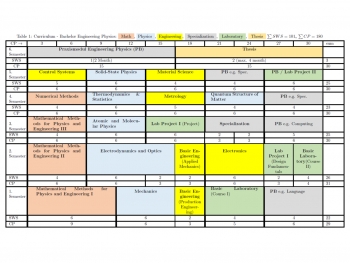University of Applied Sciences Emden/Leer
Courses are held in English, additional German courses are available. Participants can choose to write the Bachelor's thesis in either language.
The application deadline is 15 October. However, it is recommend that applicants send in their applications by 1 July.
During the first two years, students will concentrate on physics and mathematics combined with an introduction to topics on engineering. In the laboratory projects, students are gradually introduced to self-contained laboratory work. The subject of specialisation (Laser & Optics, Biomedical Physics, Acoustics and Renewable Energy) is introduced in the third semester. Business administration and languages are part of the programme. Students have to complete an internship in the sixth semester.
Biomedical Physics
Modern medicine employs a multitude of sophisticated, physically based techniques both in therapy and diagnostics. Providing at first a basic foundation in anatomy and physiology, the specialisation "Biomedical Physics" goes on to emphasise on modern methods in medical radiation applications such as radiotherapy, nuclear medicine or radiology and basics of minimal invasive therapy including micromechanical and laser assisted methods as well as other imaging techniques such as ultrasound, Nuclear Magnetic Resonance and optical tomography. Well-established medical engineering physics such as medical electronics, data and image acquisition and processing, radiation biophysics, laboratory diagnostics and biomechanics are also covered. Combining engineering, scientific and biomedical skills, the graduate is well equipped with urgently needed qualifications for medical research and development. Training in the field of medical radiation physics is performed in cooperation with the Medical Centre for Radiotherapy and Nuclear Medicine at the Pius-Hospital Oldenburg.
Acoustics
The specialisation "Sound & Vibration" covers infrasound, audible sound, ultrasound and structure born sound and mechanical vibrations. Topics address digital signal processing, basics of radiation and wave propagation, physical and technical properties of electro-acoustic transducers, numerical calculation of mechanical vibrations, acoustic properties of matter, and evaluation of the impact of sound and vibrations on humans. Subjective perception of sound, physics of the ear, sound design of products, sound environment of transportation means, and noise abatement are fields of research in Oldenburg.
Laser & Optics
Laser technology and optics are key technologies of the 21st century. Fibre optic networks for data transmission, optical data carriers, or lithography for the production of microchips are examples. Optical diagnostics are indispensable in medicine and environmental technology. Lasers are a tool for cutting, welding, drilling, perforating and marking.
Renewable Energy
Education in the field of Renewable Energy (RE) is strongly correlated with models of the future energy supply. Much of the research in RE is conducted in disciplines like physics and engineering. RE research and education at the University of Oldenburg is focused on physical, technical, ICT, and economic issues of RE power generation and its system integration. Detailed information on RE based research, RE-related educational programmes (Bachelor's/Master's), and the diversity of RE courses can be found on the platform for the study of Renewable Energy at the University of Oldenburg.


